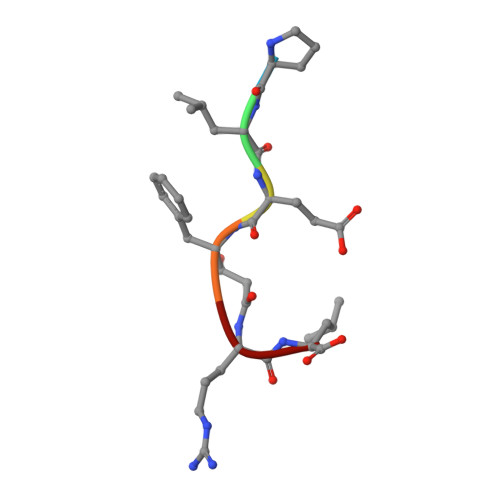A structural comparison of 21 inhibitor complexes of the aspartic proteinase from Endothia parasitica.
Bailey, D., Cooper, J.B.(1994) Protein Sci 3: 2129-2143
- PubMed: 7703859
- DOI: https://doi.org/10.1002/pro.5560031126
- Primary Citation of Related Structures:
1EPL, 1EPM, 1EPN, 1EPR - PubMed Abstract:
The aspartic proteinases are an important family of enzymes associated with several pathological conditions such as hypertension (renin), gastric ulcers (pepsin), neoplastic disease (cathepsins D and E), and AIDS (HIV proteinase). Studies of inhibitor binding are therefore of great importance for design of novel inhibitors for potential therapeutic applications. Numerous X-ray analyses have shown that transition-state isostere inhibitors of aspartic proteinases bind in similar extended conformations in the active-site cleft of the target enzyme. Upon comparison of 21 endothiapepsin inhibitor complexes, the hydrogen bond lengths were found to be shortest where the isostere (P1-P'1) interacts with the enzyme's catalytic aspartate pair. Hydrogen bonds with good geometry also occur at P'2, and more so at P3, where a conserved water molecule is involved in the interactions. Weaker interactions also occur at P2, where the side-chain conformations of the inhibitors appear to be more variable than at the more tightly held positions. At P2 and, to a lesser extent, P3, the side-chain conformations depend intriguingly on interactions with spatially adjacent side chains, namely P'1 and P1, respectively. The tight binding at P1-P'1, P3, and P'2 is also reflected in the larger number of van der Waals contacts and the large decreases in solvent-accessible area at these positions, as well as their low temperature factors. Our analysis substantiates earlier proposals for the locations of protons in the transition-state complex. Aspartate 32 is probably ionized in the complexes, its charge being stabilized by 1, or sometimes 2, hydrogen bonds from the transition-state analogues at P1. The detailed comparison also indicates that the P1 and P2 residues of substrate in the ES complex may be strained by the extensive binding interactions at P3, P'1, and P'2 in a manner that would facilitate hydrolysis of the scissile peptide bond.
- Department of Crystallography, Birkbeck College, University of London, United Kingdom.
Organizational Affiliation:


















